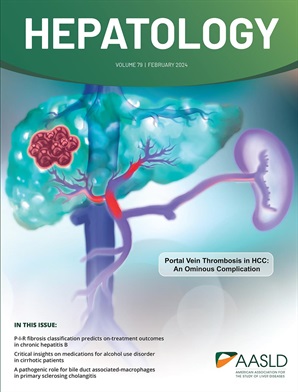Association between longitudinal weight change and clinical outcome in individuals with MASLD.
IF 15.8
1区 医学
Q1 GASTROENTEROLOGY & HEPATOLOGY
引用次数: 0
Abstract
BACKGROUND Weight control remains the cornerstone for metabolic dysfunction-associated steatotic liver disease (MASLD) management. We assessed the relationships between dynamic weight change and the risk of liver-related events (LREs) and liver stiffness changes in MASLD. METHODS By enrolling adult MASLD individuals with ≥2 weight measurements from 16 tertiary referral centers, we assessed how longitude weight change, including the following categories (stable ≤5% change, weight loss >5% decrease, weight gain >5% increase) and changing status of obesity (persistent non-obesity, persistent obesity, transition from non-obesity to obesity, transition from obesity to non-obesity), were associated with LREs. Analyses were undertaken with multivariable linear regressions, Cox proportional hazards regression and logistic regression adjusting for age, sex, ethnicity, baseline BMI, hypertension, T2D, LSM, CAP, and SGLT-2i/GLP-1RAs usage. Analyses between weight change and liver stiffness change were also undertaken. RESULTS 10,014 MASLD individuals with ≥2 weight measurements were included. Over a measurement interval of 29.2 months, 123 LREs occurred during 12.4 months follow-up after the final weight assessment. Weight gain >5% was associated with increased risk of LREs (aHR=1.84(95%CI:1.01-3.09), P=0.020) and liver stiffness progression (aOR=2.07(95%CI:1.55-2.74), P<0.001), while weight loss >5% exhibited liver stiffness improvement. Although those who progressed to or persisted with obesity, had higher LREs risk, obesity reversal had a comparable LREs risk (aHR=1.44(95%CI:0.57-3.61), P=0.435) to the persistent non-obese. CONCLUSIONS In MASLD, weight gain is associated with increased LREs risks and liver stiffness progression. Conversely, weight loss confers benefits for liver stiffness improvement and modifies LREs risk in those who achieve obesity reversal.MASLD患者纵向体重变化与临床结果的关系
背景:体重控制仍然是代谢功能障碍相关脂肪变性肝病(MASLD)管理的基石。我们评估了动态体重变化与MASLD患者肝脏相关事件(LREs)风险和肝脏僵硬度变化之间的关系。方法通过纳入来自16个三级转诊中心的体重≥2次的成年MASLD个体,我们评估了经度体重变化(包括以下类别(稳定≤5%变化,体重减轻>下降5%,体重增加>增加5%)和肥胖状态变化(持续非肥胖,持续肥胖,从非肥胖过渡到肥胖,从肥胖过渡到非肥胖)如何与LREs相关。采用多变量线性回归、Cox比例风险回归和logistic回归进行分析,调整年龄、性别、种族、基线BMI、高血压、T2D、LSM、CAP和SGLT-2i/GLP-1RAs的使用情况。还对体重变化和肝脏硬度变化进行了分析。结果纳入10014例体重≥2次的MASLD患者。在29.2个月的测量间隔中,在最终体重评估后的12.4个月随访期间发生了123例LREs。体重增加0.5%与LREs风险增加(aHR=1.84(95%CI:1.01-3.09), P=0.020)和肝脏僵硬进展(aOR=2.07(95%CI:1.55-2.74)相关,P5%表现出肝脏僵硬改善。虽然那些进展为肥胖或持续肥胖的人有更高的LREs风险,但肥胖逆转与持续非肥胖者的LREs风险相当(aHR=1.44(95%CI:0.57-3.61), P=0.435)。结论:在MASLD中,体重增加与LREs风险增加和肝脏僵硬进展相关。相反,体重减轻有利于改善肝脏硬度,并改变那些实现肥胖逆转的人的LREs风险。
本文章由计算机程序翻译,如有差异,请以英文原文为准。
求助全文
约1分钟内获得全文
求助全文
来源期刊

Hepatology
医学-胃肠肝病学
CiteScore
27.50
自引率
3.70%
发文量
609
审稿时长
1 months
期刊介绍:
HEPATOLOGY is recognized as the leading publication in the field of liver disease. It features original, peer-reviewed articles covering various aspects of liver structure, function, and disease. The journal's distinguished Editorial Board carefully selects the best articles each month, focusing on topics including immunology, chronic hepatitis, viral hepatitis, cirrhosis, genetic and metabolic liver diseases, liver cancer, and drug metabolism.
 求助内容:
求助内容: 应助结果提醒方式:
应助结果提醒方式:


